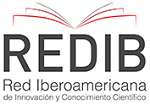Desarrollo de una metodología para la predicción de curvas características en bombas periféricas.
DOI:
https://doi.org/10.15649/2346030X.756Palabras clave:
Balance energético; Bomba; Dinámica de fluidos; Metodología; ModeloResumen
Las bombas rotodinámicas han presentado un desarrollo muy notable en los últimos años; debido a esto, su implementación
se ha diversificado ampliamente en aplicaciones industriales y domiciliarias. La modificación de los parámetros de operación que definen las
características de la bomba regenerativa afecta directamente su eficiencia. Por otro lado, las curvas características que determinan el
comportamiento hidráulico de una bomba son utilizadas para definir el punto de operación y escoger una bomba adecuada para las condiciones
de funcionamiento de un sistema hidráulico. En este artículo, se presenta una metodología para ajustar la curva teórica de una bomba
rotodinámica periférica utilizando factores que influyen en su desempeño considerando que limitaciones físicas que se presentan durante su
operación afectan la precisión en la descripción del fenómeno. La ecuación de Euler es utilizada para determinar un conjunto de correlaciones
que describen el comportamiento real de la bomba periférica tomando en cuenta la velocidad absoluta del alabe y la componente periférica de
la velocidad del fluido que interactúa con el rodete; luego, los datos generados son utilizados para comparar la ecuación de la velocidad del flujo
definida con la caracterización geométrica de una bomba regenerativa disponible en el mercado. Por último, se desarrolló una modificación en
la ecuación teórica de Euler para predecir la curva real de la bomba regenerativa alcanzando un porcentaje de error menor al 5%.
Referencias
F. Posso, J.C. Acevedo-Paez y J. Hernández, “El impacto económico de las energías renovables,” Aibi Rev. Investig. Adm. e Ing., pp. 22–26, Jul. 2014.
G. Silva-Monsalve, “Ciencia, tecnología e innovación: un análisis filosófico y psicológico desde lo abstracto hacia lo fáctico,” Aibi Rev. Investig. Adm. e Ing., pp. 2–7, Jan. 2019.
J.D. Smith, V. Sreedharan, M. Landon y Z.P. Smith, “Advanced design optimization of combustion equipment for biomass combustion,” Renew. Energy, vol. 145, pp. 1597–1607, 2020.
T.K. Ibrahim y M.M. Rahman, “Optimum Performance Improvements of the Combined Cycle Based on an Intercooler–Reheated Gas Turbine,” J. Energy Resour. Technol., vol. 137, no. 6, 2015.
G. Khankari, J. Munda y S. Karmakar, “Power Generation from Condenser Waste Heat in Coal-fired Thermal Power Plant Using Kalina Cycle,” Energy Procedia, vol. 90, no. December 2015, pp. 613–624, 2016.
C. Liu, W. Bu y D. Xu, “Multi-objective shape optimization of a plate-fin heat exchanger using CFD and multi-objective genetic algorithm,” Int. J. Heat Mass Transf., 2017.
J. Wen, Y. Li, A. Zhou y K. Zhang, “An experimental and numerical investigation of flow patterns in the entrance of plate-fin heat exchanger,” Int. J. Heat Mass Transf., vol. 49, no. 9–10, pp. 1667–1678, May 2006.
A. Bengoechea, R. Antón, G.S. Larraona, A. Rivas, J.C. Ramos y Y. Masip, “PIV measurements and a CFD benchmark study of a screen under fan-induced swirl conditions,” Int. J. Heat Fluid Flow, vol. 46, pp. 43–60, 2014.
Z. Zhang, LDA application methods: laser Doppler anemometry for fluid dynamics, no. 1. Switzerland: Springer Heidelberg, 2010.
M. Yari, “Exergetic analysis of various types of geothermal power plants,” Renew. Energy, vol. 35, no. 1, pp. 112–121, 2010.
C.N. Jayapragasan y K.J. Reddy, “Design optimization and experimental study on the blower for fluffs collection system,” J. Eng. Sci. Technol., vol. 12, no. 5, pp. 1318–1336, 2017.
M. Cudina, “Detection of cavitation phenomenon in a centrifugal pump using audible sound,” Mech. Syst. Signal Process., vol. 17, no. 6, pp. 1335–1347, 2003.
E.C. Bacharoudis, A.E. Filios, M.D. Mentzos y D.P. Margaris, “Parametric study of a centrifugal pump impeller by varying the outlet blade angle,” Open Mech. Eng. J., vol. 2, no. 5, pp. 75–83, 2008.
X. Qiu, D. Japikse, J. Zhao y M.R. Anderson, “Analysis and Validation of a Unified Slip Factor Model for Impellers at Design and Off-Design Conditions,” J. Turbomach., vol. 133, no. 4, 2011.
M. Badami y M. Mura, “Theoretical model with experimental validation of a regenerative blower for hydrogen recirculation in a PEM fuel cell system,” Energy Convers. Manag., vol. 51, no. 3, pp. 553–560, Mar. 2010.
M.W. Heo, T.W. Seo, H.S. Shim y K.Y. Kim, “Optimization of a regenerative blower to enhance aerodynamic and aeroacoustic performance,” J. Mech. Sci. Technol., vol. 30, no. 3, pp. 1197–1208, Mar. 2016.
S.Y. Jeon, C.K. Kim, S.M. Lee, J.Y. Yoon y C.M. Jang, “Performance enhancement of a pump impeller using optimal design method,” J. Therm. Sci., vol. 26, no. 2, pp. 119–124, Apr. 2017.
MEPCO, “Marshall Engineered Products.” [En línea]. Disponible en: http://www.mepcollc.com/pdf/products/Regenerative_Turbine_Pumps_1484.pdf. [Accessed: 06-Jan-2016].
C. Mataix, “Mecánica de Fluidos y Máquinas Hidráulicas”, Edición: 2. México: Marcombo, 2004.
F. Zhang, K. Chen, D. Appiah, B. Hu, S. Yuan y S.N. Asomani, “Numerical Delineation of 3D Unsteady Flow Fields in Side Channel Pumps for Engineering Processes,” Energies, vol. 12, no. 7, p. 1287, Apr. 2019.
F. Zhang, D. Appiah, J. Zhang, S. Yuan, M.K. Osman y K. Chen, “Transient flow characterization in energy conversion of a side channel pump under different blade suction angles,” Energy, vol. 161, pp. 635–648, Oct. 2018.
T. Meakhail y S. Park, “An improved theory for regenerative pump performance,” Proc. Inst. Mech. Eng. Part A-journal Power Energy - PROC INST MECH ENG A-J POWER, vol. 219, pp. 213–222, 2005.
T. Capurso, L. Bergamini y M. Torresi, “Design and CFD performance analysis of a novel impeller for double suction centrifugal pumps,” Nucl. Eng. Des., vol. 341, no. 2019, pp. 155–166, 2019.
A. M. Sl y D.J.M. Issac, “Design and analysis of centrifugal pump impeller using ansys fluent,” vol. 4, no. 10, p. 4, 2015.
I. Hernandez-Carrillo, C.J. Wood y H. Liu, “Advanced materials for the impeller in an ORC radial microturbine,” Energy Procedia, vol. 129, pp. 1047–1054, 2017.
W.P. Adamczyk et al., “Application of LES-CFD for predicting pulverized-coal working conditions after installation of NOx control system,” Energy, vol. 160, pp. 693–709, 2018.
Y. Sun, W. Liu y T. yu Li, “Numerical investigation on noise reduction mechanism of serrated trailing edge installed on a pump-jet duct,” Ocean Eng., vol. 191, Nov. 2019.
T. Capurso et al., “Numerical investigation of cavitation on a NACA0015 hydrofoil by means of OpenFOAM,” Energy Procedia, vol. 126, pp. 794–801, 2017.
T.A. Meakhail, “Numerical study of unsteady flow characteristics in regenerative pump,” 2007.
M.A. Mohammadi y A. Jafarian, “CFD simulation to investigate hydrodynamics of oscillating flow in a beta-type Stirling engine,” Energy, vol. 153, pp. 287–300, Jun. 2018.
J. Yao, W. Jin, y Y. Song, “RANS simulation of the flow around a tanker in forced motion,” Ocean Eng., vol. 127, no. October, pp. 236–245, 2016.
M. García-Pérez y E. Vakkilainen, “A comparison of turbulence models and two and three dimensional meshes for unsteady CFD ash deposition tools,” Fuel, vol. 237, no. September 2018, pp. 806–811, 2019.
B. Olcucuoglu y B.H. Saracoglu, “A preliminary heat transfer analysis of pulse detonation engines,” in Transportation Research Procedia, 2018, vol. 29, pp. 279–288.
F. Quail, M. Stickland y S. Thomas, “Rapid Manufacturing Technique used in the Development of a Regenerative Pump Impeller,” Lect. Notes Eng. Comput. Sci., vol. 16, 2009.
J. Vencels, P. Råback y V. Geža, “EOF-Library: Open-source Elmer FEM and OpenFOAM coupler for electromagnetics and fluid dynamics,” SoftwareX, vol. 9, pp. 68–72, 2019.
A. M. González, M. Vaz y P.S.B. Zdanski, “A hybrid numerical-experimental analysis of heat transfer by forced convection in plate-finned heat exchangers,” Appl. Therm. Eng., vol. 148, pp. 363–370, Feb. 2019.
S.H. Kang y S.H. Ryu, “Reynolds Number Effects on the Performance Characteristic of a Small Regenerative Pump,” J. Fluids Eng. Asme - J FLUID ENG, vol. 131, 2009.
W. Lyu y O. el Moctar, “Numerical and experimental investigations of wave-induced second order hydrodynamic loads,” Ocean Eng., vol. 131, no. May 2016, pp. 197–212, 2017.
V. Bone, R. McNaughton, M. Kearney y I. Jahn, “Methodology to develop off-design models of heat exchangers with non-ideal fluids,” Appl. Therm. Eng., vol. 145, pp. 716–734, Dec. 2018.
F.J. Quail, T. Scanlon y A. Baumgartner, “Design study of a regenerative pump using one-dimensional and three-dimensional numerical techniques,” Eur. J. Mech. B/Fluids, vol. 31, no. 1, pp. 181–187, Jan. 2012
Roth Pump Company, “ROTH PUMP COMPANY.” [Online]. Available: http://www.rothpump.com/index.html. [Accessed: 01-Feb-2016].
K. Vasudeva-Karanth y N.Y. Sharma, CFD Analysis of a Regenerative Pump for Performance Enhancement. 2014.
N.D. Karlsen-Davies y G.A. Aggidis, “Regenerative liquid ring pumps review and advances on design and performance,” Applied Energy, vol. 164. Elsevier Ltd, pp.
Descargas
Publicado
Cómo citar
Descargas
Número
Sección
Licencia
La revista ofrece acceso abierto bajo una Licencia Creative Commons Attibution License

Esta obra está bajo una licencia Creative Commons Attribution (CC BY 4.0).










